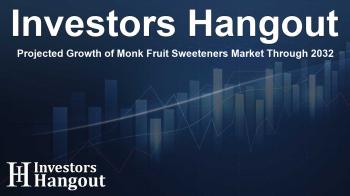Projected Growth of Monk Fruit Sweeteners Market Through 2032

Monk Fruit Sweeteners Market Growth Overview
The monk fruit sweeteners market is witnessing a significant transformation, spurred by health-conscious consumers seeking natural alternatives to sugar. This market is projected to experience a steady growth trajectory, reaching a remarkable $147.2 million by 2032. The expected compound annual growth rate (CAGR) is estimated at 4.5% from 2025 to 2032, reflecting a rising demand for healthier sweetening options.
Market Segmentation and Insights
Understanding the monk fruit sweeteners market involves a close look at its diverse applications and product types. Key factors contributing to market growth include versatility, increasing consumer demand for organic products, and the rising prevalence of diabetes.
Product Type Analysis
Monk fruit extracts remain at the forefront of the market, with numerous applications across baked goods, beverages, and dietary supplements. Additionally, monk fruit juice concentrates are becoming popular for their natural beverage formulations, while monk fruit infusions expand into health and wellness categories. The concentrated sweetness of these products allows manufacturers to achieve desired sweetness levels using smaller quantities, appealing to both health-conscious and environmentally aware consumers.
Form and Application Segmentation
In terms of form, the solid form of monk fruit sweeteners currently holds a significant market share, primarily due to its ease of handling, storage, and superior shelf life. Conversely, the liquid form is gaining traction, especially within the beverage sector where processing convenience is essential.
Regional Market Insights
The monk fruit sweeteners market is experiencing diverse regional developments. North America takes the lead with a 52.8% market share, driven by an increase in health-consciousness and awareness of diabetes. Meanwhile, the Asia-Pacific region is expected to grow at a remarkable CAGR of 5.1%, with China leading as the largest producer of monk fruit. Europe also presents promising growth opportunities as consumers become more inclined toward clean-label products.
Drivers of Market Growth
A number of key drivers are propelling the growth of the monk fruit sweeteners market:
- Rising health consciousness leading to a demand for natural and zero-calorie sugar alternatives.
- Expanding interest in organic food and beverage products featuring clean-label characteristics.
- Increasing prevalence of diabetes and obesity prompts more people to seek low-calorie sweetener options.
- Innovations promising sweetness levels 100-250 times greater than traditional sugar.
- Consumer preference for sweeteners that are free from artificial additives and genetically modified organisms.
- A clean-label trend, with a significant number of consumers willing to pay a premium for transparency in product ingredients.
Emerging Opportunities in the Monk Fruit Sweeteners Market
The market for monk fruit sweeteners is also presenting numerous opportunities for expansion:
- Growing acceptance of monk fruit sweeteners in European and Latin American markets.
- Increased consumer interest in natural sweeteners as replacements for artificial alternatives.
- Rising demand for products with clean-label commitments emphasizing natural ingredients.
- Opportunities for premium positioning of organic monk fruit sweeteners, appealing to health-oriented consumers.
Challenges Facing the Market
While the monk fruit sweeteners market is poised for growth, several challenges must be navigated:
- Strict government regulations impacting product approval and market entry processes.
- The higher price point of monk fruit sweeteners compared to traditional artificial sweeteners may limit widespread adoption.
- Limited consumer awareness about the benefits of monk fruit sweeteners in emerging markets.
- Complexities in the supply chain, particularly because China serves as the primary source for monk fruit production.
Concluding Insights
The monk fruit sweeteners market represents an exciting opportunity for innovation within the food and beverage sector. With the health-conscious movement gaining momentum, the appeal of monk fruit sweeteners as a natural, zero-calorie alternative is undeniable. Market players are encouraged to keep up with consumer trends, invest in product innovation, and explore the diverse regions where demand continues to grow.
Frequently Asked Questions
1. What is the projected value of the monk fruit sweeteners market by 2032?
The monk fruit sweeteners market is projected to reach $147.2 million by 2032.
2. What growth rate is expected for this market?
The market is expected to grow at a CAGR of 4.5% from 2025 to 2032.
3. Which region leads in market share for monk fruit sweeteners?
North America currently dominates the market with a 52.8% share.
4. What are the main challenges facing this market?
Challenges include stringent regulations, higher prices compared to artificial sweeteners, and consumer awareness in emerging markets.
5. Why are consumers turning to monk fruit sweeteners?
Consumers are seeking healthier, natural alternatives to sugar, prompted by health concerns including diabetes and obesity.
About The Author
Contact Evelyn Baker privately here. Or send an email with ATTN: Evelyn Baker as the subject to contact@investorshangout.com.
About Investors Hangout
Investors Hangout is a leading online stock forum for financial discussion and learning, offering a wide range of free tools and resources. It draws in traders of all levels, who exchange market knowledge, investigate trading tactics, and keep an eye on industry developments in real time. Featuring financial articles, stock message boards, quotes, charts, company profiles, and live news updates. Through cooperative learning and a wealth of informational resources, it helps users from novices creating their first portfolios to experts honing their techniques. Join Investors Hangout today: https://investorshangout.com/
The content of this article is based on factual, publicly available information and does not represent legal, financial, or investment advice. Investors Hangout does not offer financial advice, and the author is not a licensed financial advisor. Consult a qualified advisor before making any financial or investment decisions based on this article. This article should not be considered advice to purchase, sell, or hold any securities or other investments. If any of the material provided here is inaccurate, please contact us for corrections.

